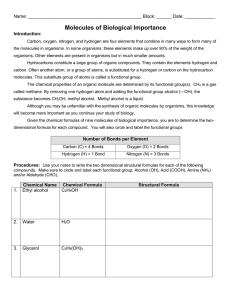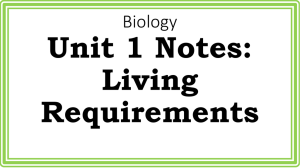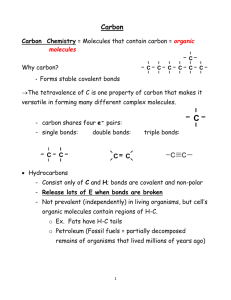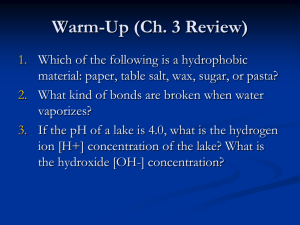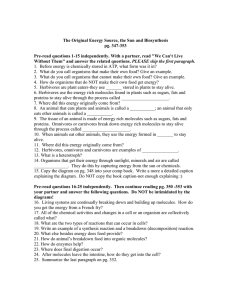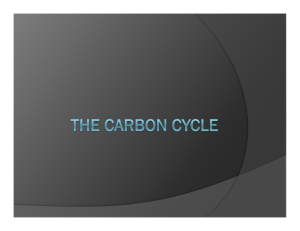Free Sample
advertisement
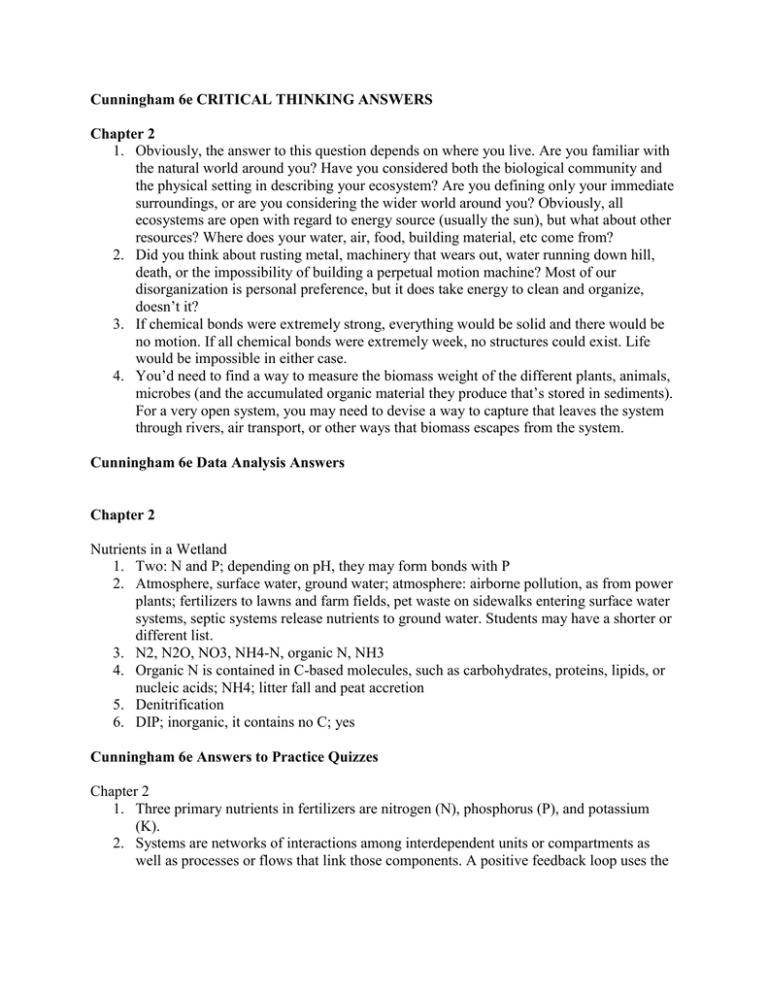
Cunningham 6e CRITICAL THINKING ANSWERS Chapter 2 1. Obviously, the answer to this question depends on where you live. Are you familiar with the natural world around you? Have you considered both the biological community and the physical setting in describing your ecosystem? Are you defining only your immediate surroundings, or are you considering the wider world around you? Obviously, all ecosystems are open with regard to energy source (usually the sun), but what about other resources? Where does your water, air, food, building material, etc come from? 2. Did you think about rusting metal, machinery that wears out, water running down hill, death, or the impossibility of building a perpetual motion machine? Most of our disorganization is personal preference, but it does take energy to clean and organize, doesn’t it? 3. If chemical bonds were extremely strong, everything would be solid and there would be no motion. If all chemical bonds were extremely week, no structures could exist. Life would be impossible in either case. 4. You’d need to find a way to measure the biomass weight of the different plants, animals, microbes (and the accumulated organic material they produce that’s stored in sediments). For a very open system, you may need to devise a way to capture that leaves the system through rivers, air transport, or other ways that biomass escapes from the system. Cunningham 6e Data Analysis Answers Chapter 2 Nutrients in a Wetland 1. Two: N and P; depending on pH, they may form bonds with P 2. Atmosphere, surface water, ground water; atmosphere: airborne pollution, as from power plants; fertilizers to lawns and farm fields, pet waste on sidewalks entering surface water systems, septic systems release nutrients to ground water. Students may have a shorter or different list. 3. N2, N2O, NO3, NH4-N, organic N, NH3 4. Organic N is contained in C-based molecules, such as carbohydrates, proteins, lipids, or nucleic acids; NH4; litter fall and peat accretion 5. Denitrification 6. DIP; inorganic, it contains no C; yes Cunningham 6e Answers to Practice Quizzes Chapter 2 1. Three primary nutrients in fertilizers are nitrogen (N), phosphorus (P), and potassium (K). 2. Systems are networks of interactions among interdependent units or compartments as well as processes or flows that link those components. A positive feedback loop uses the output from a process to increase or enhance that process; in a negative feedback loop the output of a process to inhibit or reverse that process. 3. Carbon atoms, like all matter, are constantly cycled in living organisms. Given the huge number of carbon atoms in your body, it’s almost certain that some of them were also part of some prehistoric organisms. 4. Water molecules are polar, which makes water a superb solvent. Water is the only inorganic liquid that exists at normal ambient temperatures. This provides a liquid medium for life processes. Water molecules are highly cohesive. This results in capillary action. Water expands when it crystallizes so that ice floats. Water has a high heat of vaporization, so we can remove a large amount of heat through evaporation. Water has a high specific heat, making it an ideal medium for storing heat and moderating the earth’s temperature. 5. DNA (deoxyribonucleic acid) is a molecule made up of nucleotides (purines or pyrimidines coupled to phosphate and sugar molecules) linked together in long chains. The specific sequence of nucleotides in a DNA molecule carries the genetic information that codes for protein structure and gives each organism its unique heritable characteristics. 6. High-quality energy is intense, concentrated, high-temperature, and useful for work. Low-quality energy is diffused, dispersed, low temperature, and difficult to gather or use for productive work. 7. Materials always cycle in the biosphere because of the law of conservation of matter. Energy flows in a linear fashion because of the second law of thermodynamics, which says that in every energy exchange, some of the energy is converted from higher quality to lower quality. Thus, to keep living processes going, there has to be a constant energy input and a sink to which surplus waste energy can be dumped. 8. Our eyes are sensitive only to visible light (0.4 to 0.7 um), which happens to be the most common wavelengths in solar radiation. Short ultraviolet wavelengths (microwaves (10 nm or 10 x 10-9 m) are 1 million (1 x 106) times shorter than microwaves (1 mm or 1 x 10-3 m). 9. Extremophiles live in extreme conditions at the bottom of the ocean, in hot springs, or deep in the earth’s crust. They get the energy they need to live by chemosynthesis: reactions that use chemicals, such as hydrogen sulfide or hydrogen gas as an energy source. 10. For most organisms on the earth’s surface, the ultimate source of energy is the sun, and the sink for waste energy is outer space. 11. Green plants capture solar energy through photosynthesis, a series of chemical reactions that occur in chloroplasts. The energy captured in this process is used to create chemical bonds in organic molecules. These molecules serve both as an energy source and building material for all plants and animals. 12. A species is made of all the organisms of the same kind that are able to breed under natural conditions and produce live, fertile offspring. A population consists of all the members of a species living in a given area at the same time. A biological community is made up of all the populations of different species living and interacting in a given area at a specific time. 13. Big, fierce animals (like grizzly bears, tigers, and great white sharks) are usually the top carnivores in their ecosystem. They need to be large and fierce to catch their prey. Because they are at the top of the ecological pyramid, it takes many organisms at lower trophic levels (and therefore, large home ranges) to support these big carnivores. Thus, there are never very many of them in a given area. Their adaptations as top predators make them dangerous to humans. They also often compete with us for food, so we tend to eliminate them either directly by hunting, or indirectly by reducing their food supplies or eliminating their habitat. 14. An example of an inverted ecological numbers pyramid might be a single large tree supporting many herbivorous insects, or a single coyote supporting many parasites. 15. Humans release about 7 GT of carbon annually compared to 100 GT released by respiration from land-based plants, animals, and microbes.

